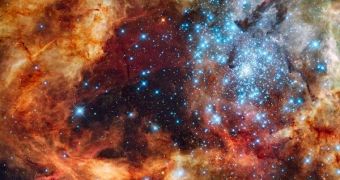The recently refurbished Hubble Space Telescope has just captured an impressive view of a large group of young stars in the 30 Doradus Nebula, which astronomers say resemble a large Christmas tree, or even Santa Claus himself. The similarities are admittedly not striking, but people tend to see patterns in everything, so, undoubtedly, most will see the holiday-related symbols. The festive photos were released just in time for Christmas for this very reason, Space reports.
The NASA space telescope was just refurbished this May, and it resumed its scientific observations just a couple of months ago. The target of its current investigations was a group of young, blue stars known as R136, which lies at the heart of the 30 Doradus Nebula, in the Large Magellanic Cloud. The latter is a group of dwarf galaxies, which lie relatively close to the Milky Way. The group, which is a part of a larger stellar nursery – an area of intense stellar formation – is estimated to be just a few million years old, therefore young by astronomical standards.
In the recently released photo, the hundreds of stars that entered Hubble's field-of-view are seen surrounded by massive clouds of cosmic dust, glowing in orange. There were probably a lot more clouds in the Nebula before these stars formed, but most of them collapsed onto themselves and ignited, creating the new celestial bodies. What amazed experts was that, in the middle of the stellar group, a relatively dark area looked just like a giant Christmas tree, adorned with blue lights.
The entire image covers no less than 100 light-years across, and was taken using Hubble's new Wide Field Camera 3 (WFC3). The telescope used three types of wavelengths – near-infrared, visible and ultraviolet – to collect the new images, which reveal a few young stars about 100 times more massive than our own Sun. The hydrogen gas cloud that surrounds all the stars is actually being stirred up by these massive stars, because the bodies are able to produce powerful stellar winds that rip their way through the stars' surroundings.

 14 DAY TRIAL //
14 DAY TRIAL //